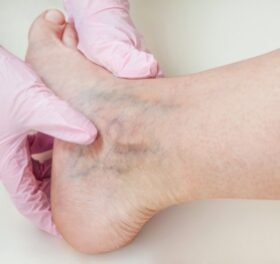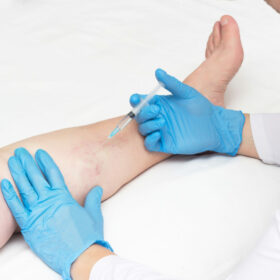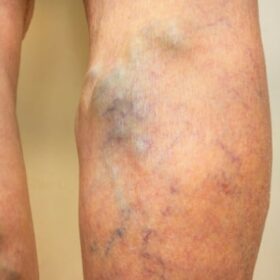If you’ve noticed unsightly bulging veins on your legs, you may be wondering if varicose veins are a cause for concern. Varicose veins and spider veins are common vascular conditions that affect millions of people worldwide. In this article, we’ll explore the causes, risk factors, potential complications, and treatment options for varicose veins. As a leading group of vein clinics led by board-certified vein doctors, we at Vein Treatment Clinic aim to provide you with comprehensive information to help you make an informed decision about your vein health.
Understanding Varicose Veins and Spider Veins
Varicose veins and spider veins are both conditions that occur when the veins become enlarged, dilated, and twisted. While they share similarities, they have some distinct characteristics.
Varicose Veins
Varicose veins are larger veins that often appear as bulging, rope-like cords on the surface of the skin. They are usually blue or purple in color and are most commonly found on the legs and thighs. Varicose veins can cause symptoms such as aching, heaviness, and discomfort, especially after prolonged periods of sitting or standing.
Spider Veins
Spider veins, also known as telangiectasia, are smaller, thin veins that resemble spider webs or tree branches. They are typically closer to the surface of the skin and can appear red, blue, or purple. Spider veins are commonly found on the face, legs, and other parts of the body. Unlike varicose veins, they rarely cause symptoms and are primarily a cosmetic concern.
If you’ve noticed unsightly bulging veins on your legs, you may be wondering if varicose veins are a cause for concern. Varicose veins and spider veins are common vascular conditions that affect millions of people worldwide. In this article, we’ll explore the causes, risk factors, potential complications, and treatment options for varicose veins. As a leading group of vein clinics led by board-certified vein doctors, we at Vein Treatment Clinic aim to provide you with comprehensive information to help you make an informed decision about your vein health.
Risk Factors for Varicose Veins
Several factors contribute to the development of varicose veins. Understanding these risk factors can help you take preventive measures and seek appropriate treatment when necessary:
- Age and Genetics: Varicose veins tend to be more prevalent in older individuals. Additionally, a family history of varicose veins increases your likelihood of developing the condition.
- Gender: Women are more likely to develop varicose veins compared to men. Hormonal changes during pregnancy, menstrual cycles, and menopause contribute to the increased risk.
- Prolonged Sitting or Standing: Occupations that involve long periods of sitting or standing can lead to poor circulation and increased pressure in the veins. This can contribute to the development of varicose veins over time.
- Obesity: Excess weight puts additional pressure on the veins, making them more susceptible to valve malfunction and vein enlargement.
- Pregnancy: During pregnancy, the body undergoes various hormonal changes and an increase in blood volume, both of which can contribute to the development of varicose veins. The pressure exerted by the growing uterus on the veins also plays a role.
Complications of Varicose Veins
Varicose veins can lead to certain medical complications if left untreated. These complications may include blood clots, ulcers, and bleeding.
Blood Clots
Varicose veins not only affect the appearance of your legs but also pose a risk of developing blood clots. When blood pools and stagnates in varicose veins, it increases the likelihood of a condition known as deep vein thrombosis (DVT). Deep vein thrombosis occurs when a blood clot forms in the deep veins, usually in the legs. If left untreated, the blood clot can break loose and travel through the bloodstream, reaching the lungs and causing a potentially life-threatening condition called pulmonary embolism.
Venous Ulcers
In severe cases of untreated varicose veins, chronic venous insufficiency can develop. Chronic venous insufficiency refers to a condition in which the veins fail to efficiently transport blood back to the heart. As a result, blood accumulates in the lower extremities, causing increased pressure and fluid leakage into the surrounding tissues. Over time, hypertension and tissue congestion can lead to the development of open sores called venous ulcers. Venous ulcers typically manifest as painful, slow-healing wounds that most commonly occur on the lower legs, near the ankles.
Bleeding
Varicose veins close to the surface of the skin are particularly vulnerable to injury and may result in unexpected bleeding. Due to the increased pressure within varicose veins, even a minor injury or a simple bump can cause significant bleeding. When the delicate vein walls are compromised, such as through a scrape, cut, or bruise, the high pressure within the veins makes them prone to bleeding. The bleeding from varicose veins can be profuse and challenging to control without medical intervention.
Treatment Options for Varicose Veins
If you’re concerned about varicose veins or experience symptoms, it’s important to consult with a vein doctor or vein specialist. At Vein Treatment Clinic, our board-certified vein doctors specialize in the diagnosis and treatment of venous conditions. After a comprehensive evaluation that may include duplex ultrasound, we will curate a personalized treatment plan based on your specific needs.
Minimally Invasive Treatments
We specialize in minimally invasive treatments that effectively target and treat varicose veins. These treatments include sclerotherapy, endovenous laser ablation, radiofrequency ablation, VenaSeal, ClariVein, and ambulatory phlebectomy. These procedures are performed on an outpatient basis, ensuring minimal downtime and a quick recovery.
Lifestyle Modifications
In addition to medical interventions, certain lifestyle modifications can help alleviate symptoms and reduce the risk of varicose veins. Regular exercise, maintaining a healthy weight, avoiding prolonged sitting or standing, and wearing compression stockings can all contribute to better vein health.
Hassle-free Insurance Verification & Convenient Locations
At Vein Treatment Clinic, we offer hassle-free insurance verification to help you understand your coverage options. We have state-of-the-art locations across the United States, including New York, New Jersey, Long Island, California, and Washington DC, making it convenient for you to access our expert vein care services.
Varicose veins are a common condition that can be a cause for concern, especially if accompanied by symptoms or complications. Understanding the risk factors, potential complications, and available treatment options is crucial for managing varicose veins effectively. At Vein Treatment Clinic, our team of board-certified vein doctors is dedicated to providing personalized, minimally invasive treatments to help you achieve healthier legs. Contact us to schedule a consultation and take the first step towards optimal vein health.











